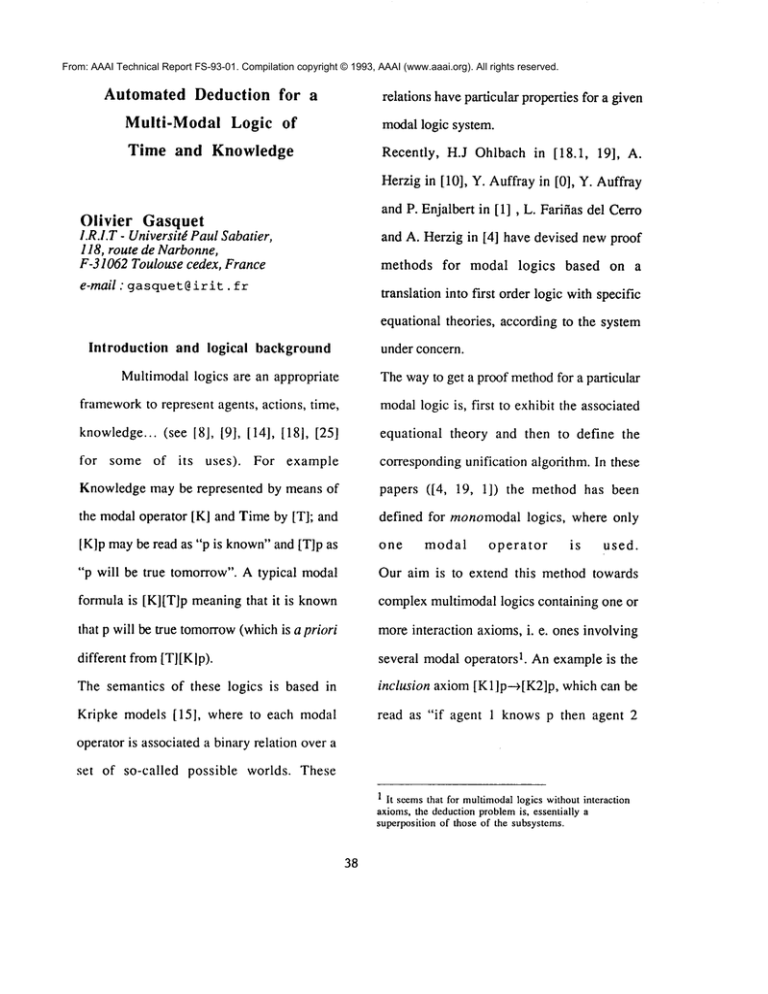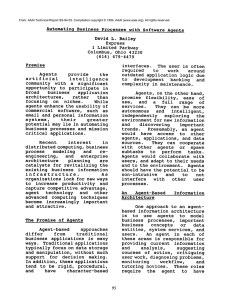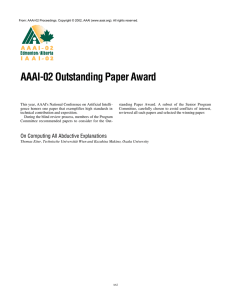
From: AAAI Technical Report FS-93-01. Compilation copyright © 1993, AAAI (www.aaai.org). All rights reserved.
Automated
Deduction
Multi-Modal
Time
and
for
Logic
a
relations have particular properties for a given
of
modal logic system.
Knowledge
Recently,
H.J Ohlbach in [18.1,
19], A.
Herzig in [10], Y. Auffray in [0], Y. Auffray
and P. Enjalbert in [1] , L. Farifias del Cerro
Olivier
Gasquet
I.R.I.T - Universit# Paul Sabatier,
118, route de Narbonne,
F-31062 Toulouse cedex, France
e-mail: gasquet@irit,
fr
and A. Herzig in [4] have devised new proof
methods for
modal logics
based on a
translation into first order logic with specific
equational theories, according to the system
Introduction
and logical
background
under concern.
Multimodal logics are an appropriate
The wayto get a proof methodfor a particular
frameworkto represent agents, actions, time,
modallogic is, first to exhibit the associated
knowledge... (see [8J, [9], [14], [18], [25]
equational
for
corresponding unification algorithm. In these
some of its
uses).
For example
Knowledge may be represented
by means of
theory and then to define the
papers ([4, 19, 1]) the method has been
the modal operator [K] and Time by [T]; and
defined for monomodallogics,
[K]p maybe read as "p is known"and [T]p as
one
"p will be true tomorrow". A typical modal
Our aim is to extend this method towards
formula is [K][T]p meaning that it is known
complex multimodal logics containing one or
that p will be true tomorrow(whichis a priori
more interaction axioms, i. e. ones involving
different from [T][KIp).
several modal operators 1. An example is the
The semantics of these logics is based in
inclusion axiom [K1]p-->[K2]p, which can be
Kripke models [15], where to each modal
read as "if agent 1 knows p then agent 2
modal
operator
where only
is
used.
operator is associated a binary relation over a
set of so-called
possible
worlds. These
1 It seems
that for multimodal
logicswithout
interaction
axioms,
the deduction
problem
is, essentiallya
superposition
of thoseof the subsystems.
38
From: AAAI Technical Report FS-93-01. Compilation copyright © 1993, AAAI (www.aaai.org). All rights reserved.
knowsp". A solution for this axiom has been
equational theory; in section 4 we define a
given in [17].
unification algorithm; finally, in section 5, we
We have been specially
interested
in
prove the termination,
automated deduction methods for modal logics
with a persistence
[KI[T]p~[TI[K]p,
soudness
and
completenessof this algorithm.
axiom of the form :
1 The multimodal logic
which has been used in
Wewill use a simplified logic system
[5], [ 18], for example.Its intuitive meaningin
in order to clarify
the presentation.
The
a "knowledge
and time" interpretation is: "if it
language of our logic is defined as usual
is knownthat tomorrow p will be true then
([12]); it is that of classical first-order logic
tomorrow it will be knownthat p is true".
plus the modal connectives [K] and [T].
That is, knowledgeabout the future persists.
Its axiomatics is based on that of first-order
It can be shownthat someof these multimodal
versions
logics can be represented in an equational
of the system Q2 for both the
connectives [K] and IT] (see again [12]), plus
order-sorted framework,with essentially two
the axiom IKIITIp~[TI[K]p
sorts
that
we call
symbols, possessing an equational
persistence axiom as in [5]. Its semantics is
axiomcapturing the persistence.
based in Kripke models M=<W,RK, RT, D,
Followingthis, the two central points of this
m>where: Wis a set of possible worlds, D is
paper are: to present a wayto deal with such a
the domainof objects, m is the interpretation
logical
axiom by translating
it into an
function mapping variables
equational theory and to define a unification
to D and n-ary
n, and, RKand
predicates to subsets of WxD
algorithmfor it. In the sequel, wedefine first
RTare accessibility relations (over W)which
a multimodal logic with persistence axiom;
verify:
then we give the target logic and a translation
i) RTand RKare serial 3, and
from the multimodallogic into the target one,
involving a particular equational theory. In
2 Q (or KD) is based on the system K and the axiom
section 3 we give a formal definition of the
[]P*<>P.
3 A binary relation R is serial iff for any wE W, there
exists w’e Wsuch that (w,w’)~
39
From: AAAI Technical Report FS-93-01. Compilation copyright © 1993, AAAI (www.aaai.org). All rights reserved.
5,
tr([KJA) = VX:K([X] tr(A))
ii) RToRK_c RKoRT4 (called
relational persistence henceforth)
tr([T]A) = VY:T([Y] tr(A)),
Proofs which are not given in this paper can
tr(<T>A) = 3Y:T([Y] tr(A)),
be found in 161.
tr(<K>A)= 3Y:K([Y] tr(A));
where,
as usual,
<K> (resp.
<T>)
2 The target logic and the translation
abbreviates ~[K]~ (resp. ~[T]~);
The language of the target logic (that wewill
and is homomorphic w.r.t,
the other
call TLhenceforth) is as follows:
connectives(--,, v .... ).
It is based on classical connectives, a set of
Now,to every (relational)
Kripke model <W,
predicate symbolsand three sets of variables
FK, FT, D, m>, we associate a (functional)
VCL, VT and VK.
That x is a variable of Vs,
model of TL:
for t amongCL, T, K, is denoted by x:s.
where Wand D are as above; and FK (resp.
FT) is a set of total functions from Wto W
Formulasare defined by:
whose graphs cover that of RK(resp. that of
p(xl:sl ..... xn:sn) is a formula, where si is
RT), moreover:
CL, T,or K and p is a predicate symbol.
-’7’t~ FT,Vk~FK, ~k’~ FK, 3t’~ FT :
11 A and B are formulas, x:s and y:s’ are
tok = k’ot’ 6 (this functional persistence
variables where s is CL, T,or K, and s’ is
captures the relational persistence RKand RT).
T,or K; then ~A, AvB, A^B, A---~B, A~--)B,
- m maps VKto FK, VT to FT, VCLto
Vx:s A, 3x:s A, and ly:s’]A are formulas.
D and n-ary predicates to subsets of WxDn;
Wepresent here, very briefly, the translation
and the sem~mticsof TL.
Thetranslation tr is definedby:
tr(A) =A,if Ais an atom.
4 Where o is relation
5 X:K denotes that X is of sort K.
6 tok is defined by: tok(w) = k(t(w)), o denotes
function composition but in the reverse order w.r.t, the
usual one. Wechoose this convention in order to keep
close to relation composition and to stress the "path"
between two points of W.
composition; (a,b)~ RToRKiff
]c~ W; (a,c)¢ RT and (c,b)e
40
From: AAAI Technical Report FS-93-01. Compilation copyright © 1993, AAAI (www.aaai.org). All rights reserved.
and if wedefine an operator ¯ such that
Now,given a formula of the original
m(o)=o, then [X:T][Y:K]A is equivalent
logic, we want to check whether or not it is a
[X:T ¯ Y:K]A(see [4]).
theorem; summarizing our results,
we have
showedin [6] that:
Note that the seriality
of both RKand RT
enables the totality of functions of FKand FT.
Satisfiability
-this formula is satisfiable
relational
in functional modelsis
semantics if and only if its
translation is satisfiable
defined as in relational ones, exceptfor:
in the
in the functional
semantics of TL$;
-there exists a clausal normalform in
M,wsat ly:slA iff M,m(y)(w)sat
TL¢(via a skolemizationstep);
m(y:s) is in Fs, wheres is T or
-the classical resolution principle ([23])
can be extended to our case, by applying
The next step of our work consists in
proving a strengthening
unification in the algebra of terms over the
theorem which
signature that we shall present below.
expresses that wecan restrict our attention to
the functional
Example:
models which enable the
The formula [T]<K><K>A
becomes, after
construction of two operators ¢~ and fir,,
translation,
having the following property:
?V’X:T 3Y:KqZ:K [X ¯ Y ¯ Z]p, which is
V t~ FT,V k~ FK:tok = ~ (t,k)o¢~
where the type of ~ (resp.
FKXFT~FT (resp.
(t,k),
skolemized in
of ~f4¢ )
[X:T ° fK(X) ° gK(X)]p, where fK and
FKXF’r~FK).
are skolem functions mappingsort T into
sort K.
As one can see, these operators are a sort of
Skolem functions.
This literal can be unified with another, say,
Adding them to the
[Y. Z]-~p
language of TL to get TL’I’, we can showthat
if andonly if:
the formula [X:TI[Y:K]A is equivalent to
a:T ¯ fK(a) ° gK(a) and Y:K¯ Z:T
I ~-C(X,Y). ~(X,Y)I
unifiable under the equational theory defined
below.
41
From: AAAI Technical Report FS-93-01. Compilation copyright © 1993, AAAI (www.aaai.org). All rights reserved.
(Z-)terms, (Z-)algebras and (Z-)substi-tutions
3 The order-sorted
equational
are defined as usual (see [11] or [26]).
framework
Consequently,
the signature
Overthis signature, weconsider the following
E we use is
equational theory denoted E and defined as
formally:
follows:
is a set of sort symbols,
S={T,K,TOP,CL}
(x:TOP
with the followingsort structure:
T _< TOP
and K _< TOP
z’TOP
U MFunT
U MFunK), is a set of operators
of our problem
persistence axiom :
(x:K,y:T)
U (CFun
¯
and the main feature
previous section).
~,~v}
y:TOP)
x ¯ (y ¯ z), i.e. ¯ is associative;
(Sort CL denotes the domain of objects; cf
F={.,
¯
¯ ~ (x,y)
=E x.y,
axiom allows some kind of permutation of
with the
types.
following declarations :
¯ : TOP,TOP-+TOP
(its interpretation
will be
We borrow definitions
of unificand,
function composition)
E-equivalence of unificands (denoted by ~),
¢’~ : K,T~ T ;
system and disjunction of systems from [13].
~¢Cv : K,T-OK;
The empty substitution will be denoted e and
for each f of CFun, f: Kk,TI,CLm --> T
~7 will denote a unificand
f : Kk,TI,CLm-+CL, where k+l+m=arityof f,
solution.
without any
and for each f of MFunT(resp. of MFunK),
f : Kk,TI,CLm--~T, (resp. f : Kk,TI,CLm-’-~K)7
4 The Algorithm
As usual we add to the signature three sets of
Presentation of the algorithm is inspired by
VTand VK, of sorts CL, T and
both [2] and [13], its input is the equation to
variables
VCL,
be solved, denoted by r=?s.
K respectively.
The following rules are used to transform a
unificand, whichis a conjunction of equations
to be solved,
7 These are three sets of skolem functions, one for each
sort of terms introduced during the skolemization step we
talked about in the previous section; neither translation,
nor skolemization introduces ternts of sort TOP, this is
why we do not use variables of sort TOP.
into
a "simpler"
E-equivalent one in the following way:
42
and
From: AAAI Technical Report FS-93-01. Compilation copyright © 1993, AAAI (www.aaai.org). All rights reserved.
considering all the rules of the form e/fi that
Occur-check (OCC)
x=?t A U
can be applied on the equation e=(r=?s), or
s--?r,
of the unificand eAU, then
e AU
;Ifx~
Vi=l...n (fi A U).
Let Sd be the set of decomposableoperators of
the signature, i.e such that Vf~ Sd:
Clash of sortsl (CST1)
(t:S=?U’V)A
;for
Clash of sorts2 (CST2)
:T°. ¯ ¯ °um:T)^
(tl :Ket2:K".¯ ¯ *tn:K=?u
I :Tou2
~V
For us,
Sd=CFunUMFunTU
MFunKU{ ff%,~ }, only
8.
¯ is not decomposable
V
Decomposition (D)
f(p 1 ..... pn)=?f(q1 ..... qn)
(pl=?qlA...Apn=?qn)
s=T or K
7
{f(pl ..... pn)=?f(ql ..... qn)}
{pl=?qlA...Apn=?qn}
and
f~g, {f(pl ..... pn)=?g(ql ..... qm)}
t and tax.
7
Eliminate (ELIM)
x:s=?t:s ^ U
^
U[x~t]
Clash of symbols (CSB)
f(p1 ..... pn)=?g(q1 ..... qm) ^
; Vf, g~Sd, f~g
; If x~ t and t~x
(for S=T or K).
Classical unification (UC)
(t:s ¯ u=?t’:s ¯ v)A
; (for S=T or K)
7
(t=?t’AU=?V)^
Persistence (PER)
Deletion (DEL)
t=?t A U
(tl:K°...*tn-l:K ° tn:K ° z:T ¯ u=?v) A
U
(tl°...°tn.1 °z’°x’*u=?vA
tn=?ff(c(z’:T,x’:K) A Z=?~(Z’,X’))A
8 Decomposability of elements of CFunUMFunTUMFunK
is given by lemma2.1.1 of [31 about free function
symbols, that of ~ and ~ is easy to establish thanks to
the rewrite systemR.
43
wherez’ and x’ are newvariables.
From: AAAI Technical Report FS-93-01. Compilation copyright © 1993, AAAI (www.aaai.org). All rights reserved.
Actually, the aim of the PERrule is to bring
of new operators. Weclaim that this method
up a subterm of sort T to the leftmost
will be helpful for manyother logic systems.
occurrence
More precisely,
of the left-hand
side term.
it seems that many of the
Sometimes, it will be possible to apply rule
useful multimodallogic systems can be treated
UCon the transformed equation as well as it
this way, i.e.
was possible on the initial one; this leads to
problems to deduction
redundancyin the generated set of solutions.
theories, through, eventually, introduction of
Therefore, the algorithm can be optimized by
new operators.
forcing
problems
to apply
rule
PER n times
by reducing their deduction
under equational
This approach will face
of theories
combination;
of
consecutively.
unification
The algorithm we have presented above is
structures...;
sound, complete and terminates.. Wewill not
structures; with non disjoint universes. Weare
give the proofs, by lack of space, but they can
currently
be found in 161.
theories
in groups or other algebraic
with more complex sort
investigating
such equational
associated to complex multimodal
logics.
Conclusion and perspectives
References
In this paper we have exposed howto
reduce a logical
[0l Yves Auffray, "Rrsolution modale et logique des
problem to a unification
chemins", Th~se de l’Universit~
[1] Yves Auffray & Patrice Enjalbert,
problem, and we have presented an algorithm
which solves the latter.
"Modal theorem
proving : An equational view point", IJCAI,
This algorithm
computes a complete set of unifiers
de Caen, 1989
1989
[2l H.-J.Biirckert,
and
"Unification theory", in K.H.Bl~ius
& H.-J.Btlrckert,
terminates, thus we get a terminating, sound
Artificial
in Artificial
and complete theorem prover for the logic of
13] H.-J.Biirckert,
knowledgeand time we are interested in (see
"Deduction Systems in
Intelligence",
Intelligence,
1989
"On Equational theories, Unification,
and (Un)Decidability",
in Kirchner editor,
"UNIFICATION",p69-115,
141 and[61).
Ellis HorwoodSeries
Academic Press,
1990
This extension of previous works has
[4] Luis Farifias del Cerro & Andreas Herzig,
"Deterministic
Modal Logic for Automated
Deduction", 9th European Conference on
been madepossible by means of introduction
Artificial
44
Intelligence,
Stockholm, 1990
From: AAAI Technical Report FS-93-01. Compilation copyright © 1993, AAAI (www.aaai.org). All rights reserved.
[5] Paul Gaborit, Alix Potet, Claudette Sayettat.
[17] Madeleine Lescot and Fran~oise Debart,
"Semantics and Validation Procedures of a
"Extension de la logique des chemins pour des
Multi-modal Logic for the Formalization of
Multi-agents Universes", 9th European
L.I.U.C,
Conference on Artificial
Stockholm,
logiques multimodales", Les cahiers du
Intelligence,
1990
expert system for aircrafts",
[6] Olivier Gasquet, "Planification
multi-agents:
Technical Report I.R.I.T
Proceedings of
Orlando (USA). Pergamon Press,
n°90-23 R,
1991.
[19] G. S. Makanin, "The problem of solvability
Toulouse, France, 1990
103. English translation
of the 3rd ACMSymposium on
Sbornik,
the Principles of Distributed Systems, p50-
in Math USSR
32, 1977
[20] Hans-JOrgen Ohlbach, "A Resolution Calculus for
81, 1984
Modal Logics", Thdse de l’Universitd
191 David Harel, "’Dynamic Logic", In Dov Gabbay and
Frans Gilnthner editors,
Kaiserslautern,
Ilanbook of
Modal Logics", Proceedings of 9th CADE,
[101 Andreas Herzig, "Raisonnement automatique en
LNCS310, Springer Verlag, 1988
logique modale et algorithme d’unification",
122] Jean-Pierre P6cuchet, ’*Equations avec constantes
Thdse de l’Universit~ Paul Sabatier, 1989
et algorithme de Makanin", Thdse de
[ 111 G6rard P.Huet & D.C.Oppen, "Equations and
l’Universit~
rewrite rules : a survey", Formal Language
the resolution
1980
principle",
JACM12, 1965
[24] Michael Rusinowitch, ’*D6monstration
"A Companion to
automatique - Techniques de r66criture",
Modal Logic", Methuen & Co. Lid, 1986
Inter6ditions,
[ 13] Claude Kirchner, "Order-sorted equational
unification", 5th Int. Conf. on Logic
Programming, Seattle,
de Rouen, 1981
[23] J.A.Robinson, "A machine oriented logic based on
theory: Perspectives and ()pen Problem.~’,
1121 G.Hugues et M.J.Cresswell,
de
1988
[21] Hans-Jtirgen Ohlbach, ’*A Resolution Calculus for
Logic, D. Rudel, 1984
Academic Press,
of
equations in a free semigroup", Mat. Sbornik,
[8] J. Halpern, "Knowledge and commonknowledge",
Philosophical
avoidance
the World Congress on Expert Systems,
r6solution et algorithmes d’unification",
Proceedings
1990
[18] MamedeLima Marques, "A collision
Paris, 1989
[25] Christel Seguin, "Une &udelogique de la
coop6ration", Revue Fratu;aise d’lntelligence
1988
Artificielle,
[14] Sarit Kraus and Daniel Lelunann, "Knowledge,
2, 1990
[26] JOrg H.Siekmann, ’*Universal unification",
7th
belief and time", In Laurent Kott editor,
Int. Conf. on Automated Deduction., Springer
Automata, Languages and Programing,
Verlag, 1984
Lecture Notes in Computer Science, 226,
p186-195, Springer Verlag, 1986.
[15] Saul Kripke, "Semantical Analysis of Modal Logic
1, Normal Propositional Calculi", Zeitschrift
fiir
mathematische Logik und Grunlagen der
Mathematik, 9, 1963
I161 P. Lescanne, "Computer experiments with the
REVETerm Rewriting Systems Generator",
lOt.h Annual ACMSymposium on Principles
of Progranlming Languages, 1983
45





